Customer Satisfaction: Benefits, Examples & Importance

Customer satisfaction is a big deal for any business. When customers are happy with your product or service, great things happen.
High satisfaction contributes significantly to the success of your business. Satisfied customers will tell their friends nice things about your company. You can surely connect the dots on how that impacts your bottom line.
This article will examine why customer satisfaction matters, how you can measure and improve it, and much more.
Want to learn how to deliver exceptional customer experience and make your business more successful?
Then, take a few minutes to read through this entire article.
Let’s get the ball rolling!
Understanding Customer Satisfaction
Customer satisfaction is a measurement of a customer’s happiness with your product or service. It is a key part of their experience with your company.
Satisfaction happens when you meet a customer’s expectations or go beyond them. Imagine a child receiving a new bike for their birthday and they ride it around with a big smile. This means they are satisfied!
Satisfaction leads to loyalty. Satisfied customers will buy from you again. They will choose you over competitors. High satisfaction means you match the customer’s expectations.
Let’s say a student needs new sneakers. They want shoes that are comfy and look cool. If the shoes they buy meet these needs, the student will be satisfied because their expectations were met.
Why is Customer Satisfaction Important?
Your customers’ satisfaction matters a lot! Here are some key reasons why:
- Happy customers will buy again. This grows your customer base over time.
- Satisfied customers tell friends about your company. This is called word-of-mouth marketing.
- It costs less to keep customers than to get new ones. Satisfaction reduces churn.
- Loyal customers will pay more for your product. They prefer your brand.
- High satisfaction scores look great to investors. This helps your company attract funding for growth.
The bottom line is that good customer satisfaction boosts sales and revenue. The importance of customer satisfaction can’t be overemphasized in growing your business!
Benefits of Customer Satisfaction
The benefits of customer satisfaction are numerous. Let’s talk about a few of them.
Business Growth
Customer satisfaction is important for growing your business. High customer satisfaction gets more people to patronize your business. This brings in more money so your company can expand.
Let’s look at two examples:
- Amazon has very high satisfaction scores. Fast shipping and good prices make customers happy. Thanks to loyal, satisfied buyers, Amazon has grown to be one of the largest companies ever.
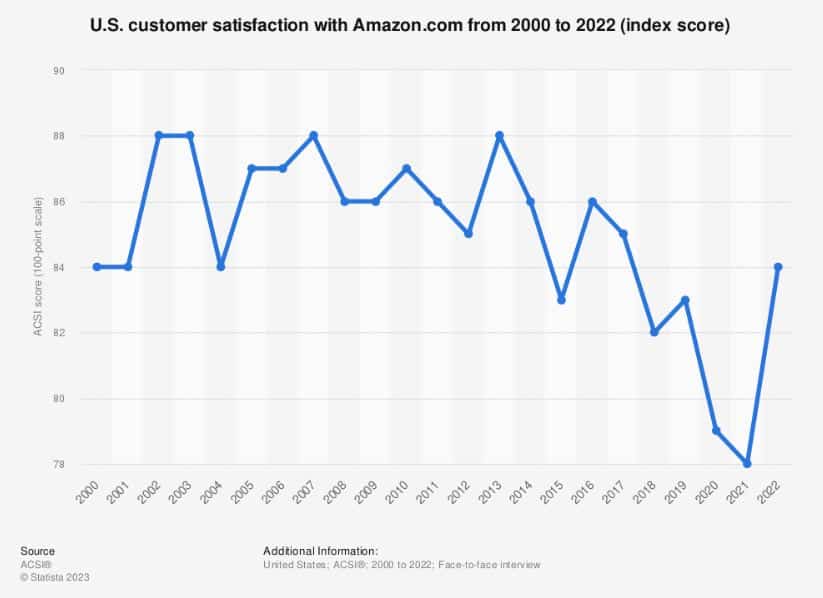
- Chick-fil-A is another fast-growing company. Its yummy food and great service satisfy customers. According to the American Customer Satisfaction Index, Chick-fil-A has maintained its #1 ranking for nine consecutive years. Many new Chick-fil-A locations pop up each year due to its legions of happy fans.
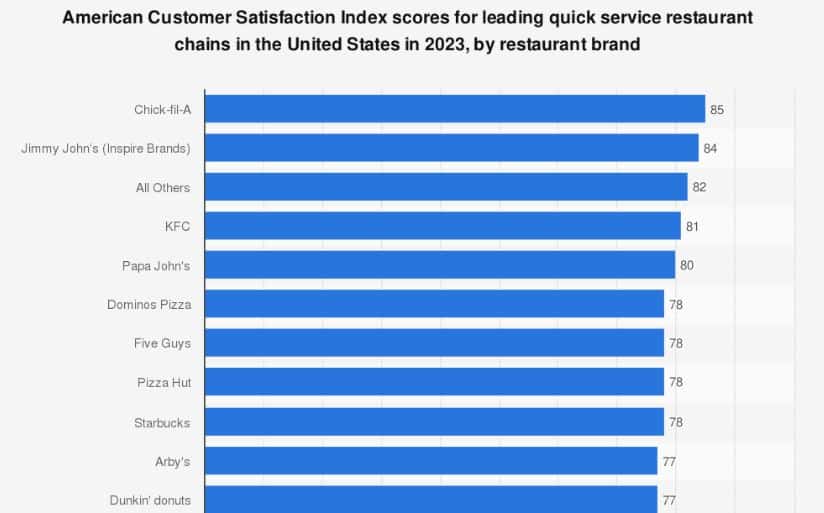
Image source: Statista.com
Tracking customer satisfaction can show if your company is growing. You can use surveys to measure how satisfied people are. If scores rise over time, your business is likely growing. Monitoring satisfaction is key to growth.
Customer Retention
Satisfied customers are loyal buyers who stick with your brand. They don’t look for competitors. This cuts down on customer churn, which is when people switch to rivals.
Happy customers have higher customer lifetime value (CLV). That’s how much they’ll spend with your business over time. Satisfied customers spend more because they like your product and service.
According to this report, if a company increases its customer retention rate by 5%, its profits increase by more than 25%.
Building loyalty through satisfaction boosts CLV. High customer satisfaction and loyalty usually go hand in hand!
Companies aim for high retention rates. A high retention rate means very few of your customers switch loyalty to your competitors.
Satisfaction is crucial for this. A satisfied customer might spend ten years and thousands of dollars with your business. That’s the power of retention!
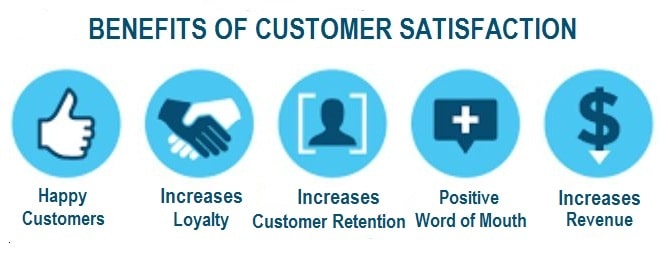
Image source: LinkedIn
Positive Word-of-Mouth
Satisfied customers rave about your company to family and friends. When your products exceed people’s expectations, they can’t wait to tell others. This generates free advertising for your business.
Positive customer feedback via word-of-mouth leads to new sales. 82% of Americans ask their friends and family for recommendations prior to purchasing anything.
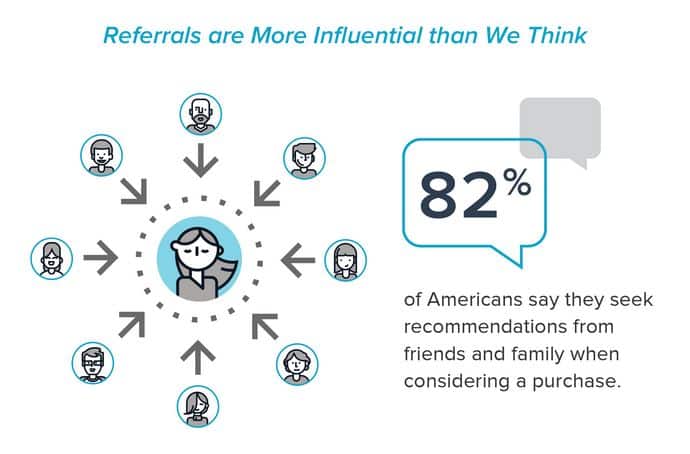
Image source: business2community.com
When someone says, “This company is terrific, you’ve got to try them!”, buyers listen.
An example is when someone loves a new restaurant. They tell all their co-workers how great it is. Many co-workers then go try the restaurant based on that recommendation.
Spreading the word increases the level of customer trust for your business. It also promotes business success as more people buy your products.
Higher Revenue
For any business, having satisfied, loyal customers is like winning the lottery every day. While acquiring new customers costs time and money, retaining happy customers keeps revenue streaming in with less effort. Let’s break down the money-making magic of customer satisfaction:
- More Purchases: Happy customers buy more and more often. They feel good about their relationship with your company and return to buy again. This spins the sales flywheel.
- Upsells: Satisfied customers are open to hearing about new offers. They trust you enough to purchase upgraded products or services. This grows the average order value.
- Price Flexibility: Loyal customers care less about minor price hikes. They value the relationship, not just the specific product. Their loyalty gives you pricing power.
Delivering great customer experience is a proven way to drive revenue. The happiest customers become your best salespeople!
Measuring Customer Satisfaction
To improve customer satisfaction, you first need to measure it. Having solid metrics provides insight into how happy customers are and where to focus improvements. Let’s explore some top techniques for tracking satisfaction.
Customer Satisfaction Metric
Metrics are stats that track how happy customers are. They give an overall view of sentiment.
Two popular metrics are the CSAT survey and Net Promoter Score (NPS).
- CSAT asks how satisfied someone was with a recent purchase. They answer on a 1 – 5 scale. The % of top scores shows the level of customer satisfaction.

- The NPS asks, “How likely are you to recommend us to a friend?” Scores are 0 – 10. Percentage of 9s & 10s minus percentage of 0 – 6s = your NPS.
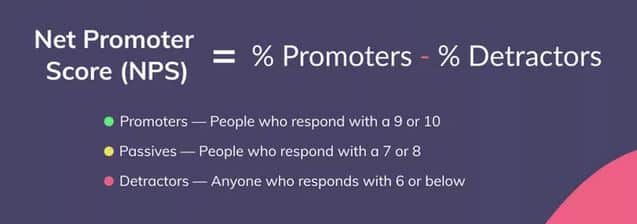
Image source: userpilot.com
CSAT works well for product feedback. NPS fits companies relying on referrals. Use metrics that fit your business.
Check satisfaction regularly with your metrics. Monthly or quarterly lets you track sentiment over time. Watch for upward trends!
Surveys as a Measurement Tool
Customer satisfaction survey collects honest opinions from customers. It gives insight into satisfaction levels.
It asks questions like:
- How satisfied were you with [product or service]?
- Did we meet your expectations?
- What could we do better?
Try to keep surveys short and anonymous. Use simple language and offer an incentive for participating.
Send surveys after purchases and interactions. Follow up with unhappy customers to fix their problems!
Feedback from surveys helps you figure out customer sentiment. Customer sentiment is like taking the temperature of relationships.
It’s the attitudes, vibes, and perceptions floating around about your brand. The intangible feelings that shape purchasing decisions.
- Positive sentiment is gold – think trust, loyalty, confidence. Customers feel good about you and recommend you to others.
- Negative sentiments like frustration and doubt sink ships. They damage reputations and send customers packing.
- Neutral sentiment means you’re not delighting but not displeasing either. Customers will switch on a dime at this level.
Sentiment gives qualitative flavor to the quantitative metrics we track. Numbers only reveal part of the story. Knowing customers’ emotions allows us to really understand them.
Examples of Customer Satisfaction Measurement
Let’s see how top brands measure and use customer satisfaction data:
- Amazon tracks metrics like return rates, reviews, and repeat purchases. They use these metrics to fix issues lowering satisfaction.
- Chick-fil-A uses surveys to get feedback on food and service. This led to adding new menu items customers wanted.
- JetBlue surveys every flight. They link feedback to employee training and keep satisfaction consistently high.
No matter how you gather data, the goal is the same – pinpoint ways to increase customer satisfaction. Then, turn those insights into action!
The key is picking metrics meaningful to your business. Track them over time. Use surveys for rich feedback. Analyze results to delight customers. Measure smart, and satisfaction will soar.
Strategies to Improve Your Customer Satisfaction Levels
How can you boost customer satisfaction in your business? Here are some handy tips:
- Exceed expectations – If customers hope for 2-day shipping, get it there in 1.
- Be reliable – Always deliver on promises like delivery times.
- Listen to feedback – Surveys, reviews, and service calls give insight into fixing problems.
- Empower staff to resolve issues – Employees should be able to handle angry customers effectively.
- Reward loyalty – Offer deals and perks to delight long-time customers.
Amazon offers great customer service. Their employees can provide refunds and solve problems without needing approval. This exceeds expectations and keeps customers happy.
Using Customer Feedback
Feedback is a goldmine for improving satisfaction and fostering customer loyalty. Here are some smart ways to leverage it:
- Send post-purchase surveys to learn what customers liked or want changed.
- Monitor reviews and social media. This alerts you to pain points or emerging issues.
- Establish a user community. Customers can suggest product improvements and discuss what they want.
- Share both positive and negative customer feedback internally. Sales, product, and support teams all gain insights to enhance customer experience.
Southwest Airlines has a strong feedback culture. Employees are empowered to address complaints immediately. Southwest uses surveys to improve its service and earn customer trust.
Continuous Improvement
View satisfaction improvement as an ongoing journey, not a one-time project. Set regular checkpoints to:
- Review metrics for changes.
- Analyze the latest feedback and identify new opportunities.
- Test changes and monitor results. Tweak further if needed.
- Update customer journey mapping based on insights.
Regular small changes compound over time. Frequent monitoring along the customer journey also catches issues early before they grow.
Building a Customer-Centric Culture
A customer-centric culture means the customer is at the center of all a company does. Their needs come first. This ideal culture should be the goal of every business.
When your team lives and breathes customer success, satisfaction levels will soar.
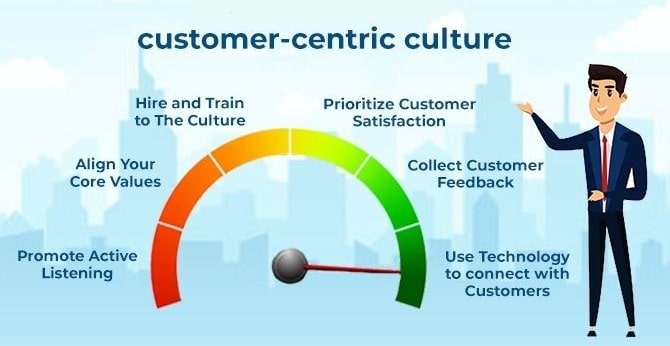
Image source: flexiventures.in
Importance of a Customer-Centric Culture
A customer-centric approach has huge benefits:
- Employees understand how their role helps customers. This bonds them to the company mission.
- Decisions consider customer needs first. This prevents self-interested choices that damage satisfaction.
- Issues get addressed faster. Staff have the mindset and power to solve problems quickly.
- Workers feel motivated to delight clients. Going the extra mile becomes natural.
A customer-focused culture leads to behaviors that improve overall satisfaction across your entire company.
Strategies to Build a Customer-Centric Culture
There are several smart ways to build your organization around the customer:
- Hire for customer-centric skills: Look for empathy, listening ability, and communication skills.
- Highlight customer stories: Share specific examples of how you satisfied clients at meetings.
- Empower employees: Give staff the freedom to resolve complaints and please customers.
- Offer customer-focused training: Teach workers how their job contributes to the client experience.
- Incentivize customer satisfaction: Tie bonuses and promotions to CSAT or NPS targets.
- Role model customer care: Leaders should prioritize customer success in all decisions.
Examples of Customer-Centric Cultures
Some shining examples of admirable customer-focused cultures include:
- Zappos – 4 weeks of customer loyalty training for all employees. Call center staff have no time limits for assisting shoppers.
- Southwest Airlines – Hiring emphasizes attitudes and people skills. Southwest invests heavily in internal customer service training programs.
- Amazon – Jeff Bezos leaves one seat open at leadership meetings to represent the customer’s perspective. Their Leadership Principles highlight customer obsession.
Adopting these types of practices will align your whole team around the shared goal of amazing customers. A customer-centric culture should be central to your satisfaction strategy.
Case Studies: Real-Life Examples of Customer Satisfaction
Let’s look at some real companies that have succeeded with customer satisfaction strategies. Studying their approach helps us learn what works.
Southwest Airlines
Southwest Airlines has set the standard for customer satisfaction in its industry. Their approach involves:
- Friendly service – Employees have fun with passengers and make travel pleasant.
- Efficiency: Point-to-point routes and streamlined operations get travelers where they want to go quickly.
- No fees – Low fares and no baggage fees make flying affordable.
A challenge was balancing low costs and high satisfaction. Southwest maintained low prices but invested in happy employees to drive great service.
This formula produces amazing results. Southwest has the highest customer satisfaction scores among U.S. airlines.
Ritz-Carlton
The Ritz-Carlton hotel chain is legendary for its luxury service. Their satisfaction strategies include:
- Anticipating needs: Staff aim to exceed guest expectations by proactively predicting wants and addressing problems.
- Empowering employees – Workers can spend up to $2,000 per guest to resolve issues immediately.
- Attention to detail – No request is too big or small if it satisfies guests.
Ritz-Carlton focused on culture and training to maintain five-star service as they grew. The Ritz-Carlton is renowned globally for its outstanding hospitality.
Amazon
Amazon tops customer satisfaction rankings year after year. Their strategy includes:
- Fast shipping – Getting orders to customers quickly exceeds expectations.
- Great prices – Low costs surprise and delight shoppers.
- User reviews – Feedback helps improve products customers actually want.
- Simple returns – Hassle-free refunds make customers feel safe buying.
Amazon faced challenges as it grew. Automating processes like sorting packages enabled fast shipping as sales volumes skyrocketed.
The outcomes have been incredible. Amazon’s focus on customer-centricity fueled its rise to one of the world’s most valuable companies.
These examples show that understanding customer satisfaction drivers in your industry. Empowering staff and constantly improving are key strategies to learn from. Keeping clients happy should guide all business decisions.
The Role of Technology in Measuring and Improving Customer Satisfaction
New tech tools can make it easier to measure and improve satisfaction. Let’s look at how top companies are using technologies to keep customers happy.
How Technology Helps Measure Satisfaction
Today, smart technology helps companies track satisfaction.
- CRM software – Customer relationship management systems store satisfaction data like survey responses. This data helps measure sentiment.
- Data analytics – Powerful programs mine customer information. They uncover trends and insights about satisfaction.
- AI tools – Artificial intelligence can classify customer survey comments as positive, negative, or neutral. This saves time analyzing feedback.
With the right tools, satisfaction metrics get calculated automatically. Companies gain clear visibility into how customers truly feel.
How Technology Improves Satisfaction
Technology also enables new ways to make customers happier.
- Support chatbots – Bots provide 24/7 answers to common issues. This improves the customer support experience.
- Personalization engines – These recommend custom products based on purchase history. Relevant suggestions delight shoppers.
- Customer dashboards – Online portals allow monitoring orders, reordering favorites, and more. This gives control over the experience.
Satisfaction levels climb when technology removes pain points and friction. Service gets faster, products get better matched, and engagement gets easier.
Examples of Companies Using Tech for Customer Satisfaction
Let’s see how leading brands use technology to measure and enhance satisfaction:
Uber – Leverages data analytics to identify high-value customers and increase their lifetime value. VIP treatment improves satisfaction.
Netflix – Uses algorithms to suggest movies and shows users will love. The carefully tailored recommendations keep subscribers happy.
Airbnb – Has an automated support system that quickly resolves issues for properties and travelers. Fast help enhances the overall experience.
The key is choosing technology aligned with your customers and business model. Tech elevates satisfaction to new heights when used right.
Customer Satisfaction Benchmarks
How does your satisfaction stack up against other companies? Benchmarks help you compare.
Benchmarks are standards or “benchmarks” for performance. We’ll look at average satisfaction rates for different industries. Then, you can see where you stand.
What Are Customer Satisfaction Benchmarks?
Benchmarks show typical satisfaction scores for a business type.
For example, the average Net Promoter Score (NPS) for restaurants is 44. If your cafe has an NPS of 60, that’s great! You’re outperforming restaurant norms.
But if your NPS is 30, you’re lagging peers. This data helps assess strengths and weaknesses.
Benchmarks also provide goals to target. You can aim to match or exceed the benchmarks for your sector.
Industry Benchmarks for Customer Satisfaction
Here are some average CSAT and NPS benchmarks by sector:
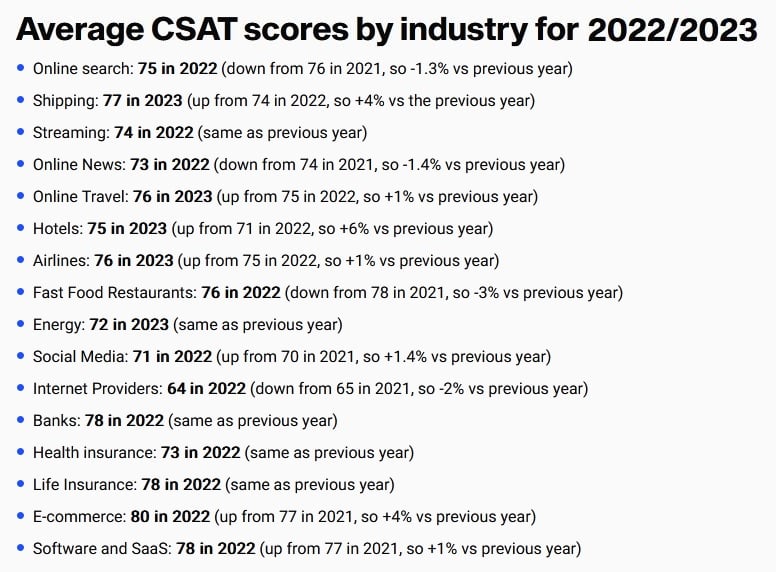
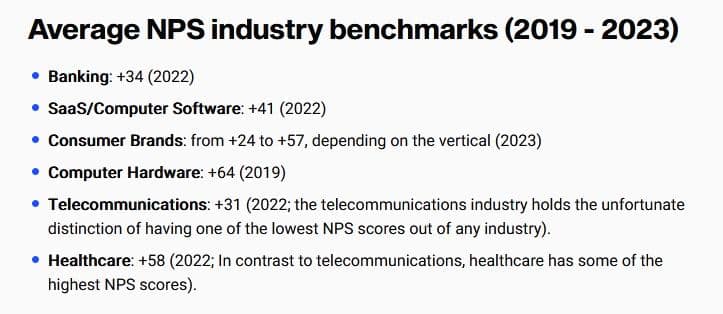
Image source: fullview.io
Check industry reports for the specific benchmarks relevant to you. Measure against these to gauge your performance.
Using Benchmarks to Set Goals
Follow these steps to leverage benchmarks:
- Research typical scores for your sector.
- Measure your current satisfaction metrics.
- Compare your metrics to benchmarks. Find areas lagging.
- Set goals to match or exceed industry averages.
- Track progress against goals and adjust efforts to hit targets.
Benchmarks make your satisfaction numbers meaningful. Scores alone don’t say much. But when compared to others, you gain valuable insight into customer sentiment.
Handling Dissatisfied Customers
Even companies with excellent service get complaints. How businesses respond to dissatisfied customers impacts loyalty. Handling issues well turns critics into raving fans.
Why Perfection is Impossible
Striving for 100% satisfaction is unrealistic. Things can go wrong like:
- Shipping delays
- Website glitches
- Employee mistakes
- Stockouts of popular items
The challenges of scale make some complaints inevitable. But with the right systems, you can minimize problems and bounce back stronger.
Turn Complaints into Opportunities
Smart companies view complaints as opportunities, not threats. Negative feedback helps you improve.
Follow best practices to capitalize on criticism:
- Make it easy to complain through multiple channels.
- Respond to complaints fast, within hours if possible.
- Empower staff to resolve issues.
- Follow up to ensure the customer is now satisfied.
- Learn from grievances to fix systemic issues.
Recovery Creates Loyal Customers
Studies show that a good recovery often increases loyalty. Customers who felt companies were indifferent early on became very pleased with swift issue resolution.
Poor experiences transform into exceptional ones when problems are fixed quickly and effectively. Dissatisfaction turns into enduring satisfaction.
Examples of Effective Complaint Management
Here are some real companies that recovered well after missteps:
Southwest Airlines – After heavily delaying passengers, they gave $100 vouchers and heartfelt apologies. Many customers praised the response.
Amazon – When Prime shipping suffered major delays, Amazon provided one-month Prime extensions and upgraded shipping. This calmed angry shoppers.
These examples illustrate that mistakes happen. What matters most is making things right. When handled well, customer complaints create positive outcomes for all.
Conclusion
In this post, we’ve explored many aspects of customer satisfaction.
The key lessons are:
- Customer satisfaction is essential for business growth, customer loyalty, referrals, and increasing revenue.
- Use surveys, CSAT, NPS, and other metrics to measure satisfaction. Compare against benchmarks to improve.
- Gather customer feedback and act on it. Fix pain points and exceed customer expectations.
- Make customer centricity central to your culture. Empower staff to resolve issues and create happy experiences.
- Leverage technology to understand your customers better and remove friction.
- Handle inevitable complaints with care. Turn critics into fans with quick fixes and empathy.
The more your company focuses on customer satisfaction, the better the outcomes. View it as an ongoing journey, not a one-time effort. Prioritize customer happiness in all you do.
With the strategies in this post, you have the knowledge to delight customers, earn loyalty, and drive growth.
Do you need help spreading the word about your customer-focused business?
AdvertiseMint’s ads services can get your satisfaction story in front of more potential customers.
Our targeted ad campaigns on Facebook, Instagram, TikTok, and Google will showcase how satisfying it is to buy from you.
We can take your business to the next level with our advertising expertise and experience.
I’m sure you want to learn more.
Click here to request a FREE Facebook ads consultation with one of our experts.
